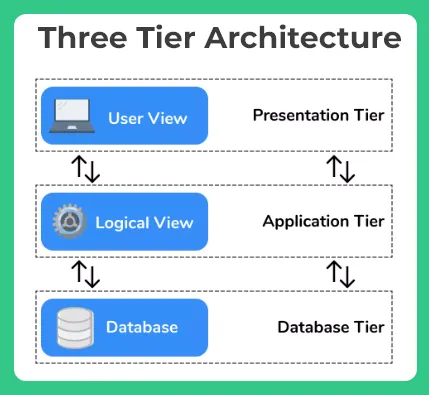0
Notifications Mark All Read
- Login
- Get Prime
DBMS Architecture (What is Architecture in DBMS)
DBMS Architecture
A DBMS has a three-level architecture, consisting of the external level, the conceptual level, and the internal level. This architecture allows for the separation of data and the logic that accesses the data, which enables the database to be updated and optimized without affecting the end-users or the administrator.
DBMS Architecture (What is Architecture in DBMS)
The following are different types of database architectures, based upon the needs and requirements of the system. One chooses the correct suitable architecture for them –
- 1 Tier Architecture
- 2 Tier Architecture
- 3 Tier Architecture
- n Tier Architecture

Single Tier Architecture
In such systems all the required components like – the interface, Middleware, and back-end data, all on one server or platform.
Most of the developers choose such systems as it’s easy and simple. But, it doesn’t provide many tools for the end-users. Thus, it is not suitable for data delivery platforms like websites globally but, may be useful for storing large data.

Two Tier Architecture
In such systems, the communication is between the client and server. The client is where the data needs to be delivered to and the server is where data is stored, updated and processed and communication between the two happens.
The application tier is there to provide communication between the two and is independent in terms of the code level logic happening at server or client.

Three Tier Architecture
This is the most widely used architecture these days and all the tiers are separated from one another. The following are the tiers –
- Database Tier – The raw data is present at this tier along with its DBMS system language and its queries that allow different operation on the DB. Example – All the database of PrepInsta website’s user resides on this tier
- Application Tier – This acts as an intermediary between the database tier and the user. The code level program that can access the database for various operation sits here. For example – if one wants to write a code for updating email ID in the database. In this case the user is not interacting with the DB directly. But, is interacting with application tier, which does its code level processing and then interacts with the database.
- Presentation Tier – This also known as user tier. Here the user is able to view all the database results. Best for his viewable format, like – if user is accessing its profile page. All the details were sent from DB to application tier and then sent to presentation tier which then displays the same in a view so that user can understand and read it. HTML/CSS is also used to modify how this data looks to the end user.

n Tier Architecture
The n tier is more customised format for corporation. Where there are n different divisions of the whole format which are related but independent of one another.
Prime Course Trailer
Related Banners
Get PrepInsta Prime & get Access to all 200+ courses offered by PrepInsta in One Subscription
Get over 200+ course One Subscription
Courses like AI/ML, Cloud Computing, Ethical Hacking, C, C++, Java, Python, DSA (All Languages), Competitive Coding (All Languages), TCS, Infosys, Wipro, Amazon, DBMS, SQL and others

 0
0



Login/Signup to comment